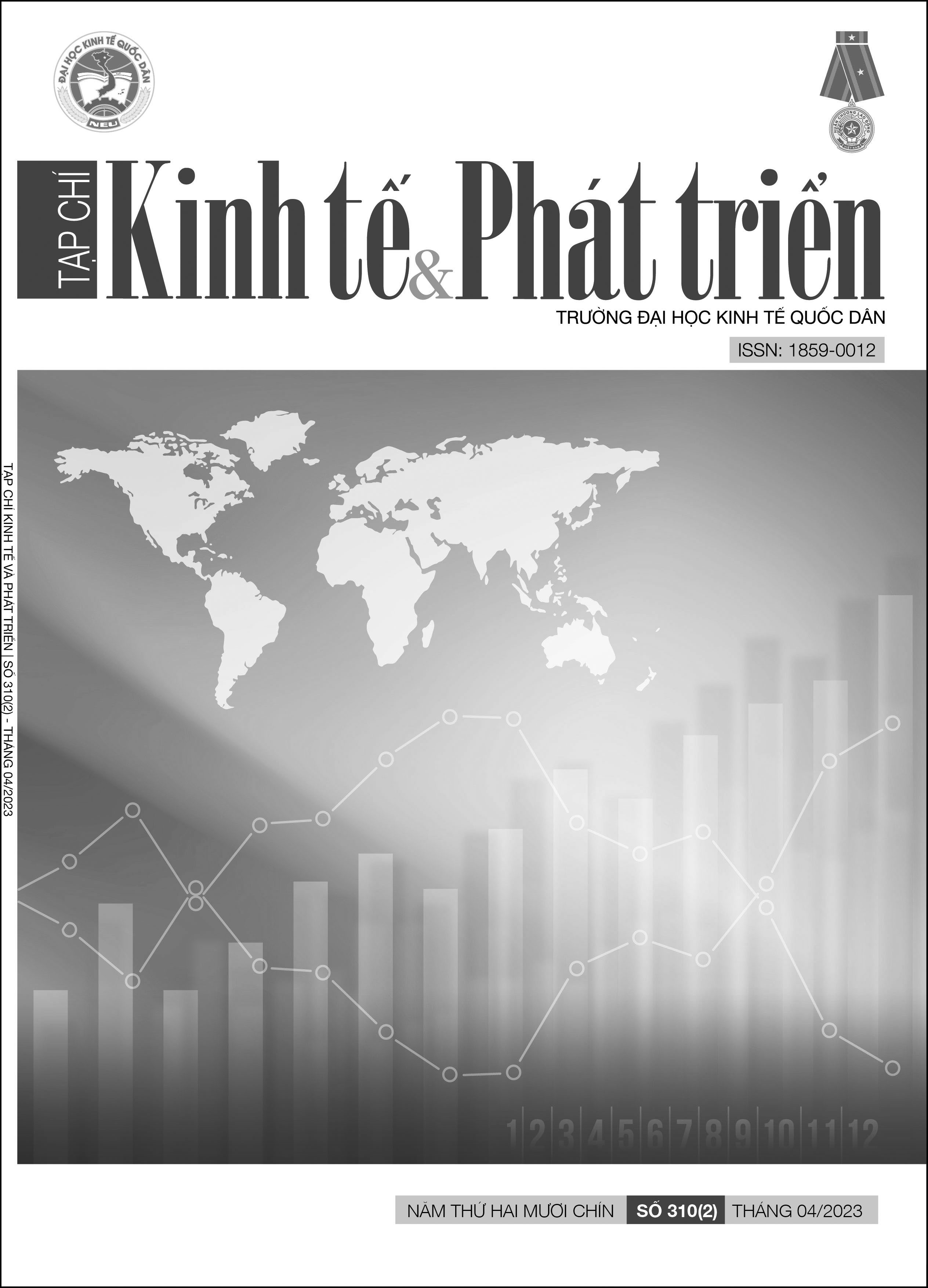Tác động của ảnh hưởng đồng trang lứa tới hành vi tiêu dùng: Vai trò của thành kiến quốc gia
DOI:
https://doi.org/10.33301/JED.VI.1219Từ khóa:
Thành kiến quốc gia, hình ảnh thương hiệu, ảnh hưởng đồng trang lứa, cảm nhận về chất lượng sản phẩm, quyết định tiêu dùngTóm tắt
Nghiên cứu này quan tâm tới lý do người tiêu dùng chọn mua mỹ phẩm Trung Quốc tại Việt Nam, là thương hiệu mỹ phẩm bình dân trong một thị trường có nhiều thương hiệu nổi tiếng và có chất lượng cao từ các nước phát triển. Nghiên cứu kiểm định tác động của ảnh hưởng đồng trang lứa tới hành vi tiêu dùng mỹ phẩm Trung Quốc trong mối quan hệ giữa cảm nhận về chất lượng và hình ảnh thương hiệu sản phẩm và vai trò điều tiết thành kiến quốc gia mà người tiêu dùng Việt Nam đang có với đất nước Trung Quốc. Mẫu nghiên cứu gồm 582 thanh niên trên địa bàn Hà Nội. Kết quả nghiên cứu cho thấy ảnh hưởng đồng trang lứa có ảnh hưởng đến cảm nhận về chất lượng sản phẩm, và hình ảnh thương hiệu, qua đó tác động tới hành vi tiêu dùng mỹ phẩm Trung Quốc. Mối quan hệ này khác biệt ở những cá nhân có thành kiến quốc gia khác nhau. Kết quả nghiên cứu gợi ý một số giải pháp cho các doanh nghiệp kinh doanh các sản phẩm thương hiệu bình dân trong tiến hành marketing sản phẩm thúc đẩy người tiêu dùng mua hàng.
Tài liệu tham khảo
Akoglu, H.E. & Özbek, O. (2022), ‘The effect of brand experiences on brand loyalty through perceived quality and brand trust: a study on sports consumers’, Asia Pacific Journal of Marketing and Logistics, 34(10), 2130-2148.
Bandura, A. & Walters, R.H. (1977), Social learning theory, Prentice Hall: Englewood cliffs, USA.
Bristol, T. & Mangleburg, T.F. (2005), ‘Not telling the whole story: Teen deception in purchasing’, Journal of the Academy of Marketing Science, 33, 79-95.
Erdogmus, I. & Büdeyri, I. (2012), ‘The role of personality congruence, perceived quality and prestige on ready-to-wear brand loyalty’, Journal of Fashion Marketing and Management, 16(4), 399-417.
Hair Jr., J.F., Rolph E., Tatham, R.L. & Black, W.C. (2010), Multivariate Data Analysis with Readings, Englewood Cliffs, NJ: Prentice-Hall, USA.
Hoang, H.T., Ho, K.N.B., Tran, T.P. & Le, T.Q. (2022), ‘The extension of animosity model of foreign product purchase: Does country of origin matter?’, Journal of Retailing and Consumer Services, 64, p.102758.
Hsieh, M.H. & Lindridge, A. (2005), ‘Universal appeals with local specifications’, Journal of Product & Brand Management, 14(1), 14-28.
Ishak, S., Che Omar, A.R., Khalid, K., Ab. Ghafar, I.S. & Hussain, M.Y. (2020), ‘Cosmetics purchase behavior of educated millennial Muslim females’, Journal of Islamic Marketing, 11(5), 1055-1071.
Khan, N., Sarwar, A. & Tan, B.C. (2021), ‘Determinants of purchase intention of halal cosmetic products among Generation Y consumers’, Journal of Islamic Marketing, 2(8), 1461-1476.
Klein, J.G., Ettenson, R. & Morris, M.D. (1998), ‘The animosity model of foreign product purchase: An empirical test in the people’s Republic of China’, Journal of Marketing, 62(1), 89-100.
Lee, K. (2009), ‘Gender differences in Hong Kong adolescent consumers' green purchasing behavior’, Journal of Consumer Marketing, 26(2), 87-96.
Lee, K. (2014), ‘Predictors of sustainable consumption among young educated consumers in Hong Kong’, Journal of International Consumer Marketing, 26(3), 217-238.
Lien, C., Wen, M., Huang, L. & Wu, K. (2015), ‘Online hotel booking: The effects of brand image, price, trust and value on purchase intentions’, Asia-Pacific Management Review, 20, 210-218.
Little, J.P., Little, E. & Cox, K.C. (2009), ‘U.S. consumer animosity towards Vietnam: A comparison of generations’, Journal of Applied Business Research, 25(6), 65-76.
Lobschat, L., Zinnbauer, M.A., Pallas, F. & Joachimsthaler, E. (2013), ‘Why social currency becomes a key driver of a firm's brand equity–insights from the automotive industry’, Long Range Planning, 46(1-2), 125-148.
Low, G.S. & Lamb Jr, C.W. (2000), ‘The measurement and dimensionality of brand associations’, Journal of Product & Brand Management, 9(6), 350-370.
Nakos, G.E. & Hajidimitriou, Y.A. (2007), ‘The impact of national animosity on consumer purchases’, Journal of International Consumer Marketing, 19(3), 53-72.
Padilla, J.A.A. (2021), ‘Decreasing consumer animosity: The relationship between fast food businesses and social conflicts in Latin America and the Caribbean’, Cogent Business & Management, 8(1), 1-21.
Santor, D.A., Messervey, D. & Kusumakar, V. (2000), ‘Measuring peer pressure, popularity, and conformity in adolescent boys and girls: Predicting school performance, sexual attitudes, and substance abuse’, Journal of Youth and Adolescence, 29, 163-182.
Sharma, V.M. & Klein A. (2020), ‘Consumer perceived value, involvement, trust, susceptibility to interpersonal influence, and intention to participate in online group buying’, Journal of Retailing and Consumer Services, 52, 1-11.
Wang, W., He, H. & Li, Y. (2013), ‘Animosity and willingness to buy foreign products: moderating factors in decision-making of Chinese consumers’, Asia Pacific Business Review, 19(1), 32-52.
Yen, Y.S. (2018), ‘Extending consumer ethnocentrism theory: the moderating effect test’, Asia Pacific Journal of Marketing and Logistics, 30(4), 907-926.
Zeithaml, V.A. (1988), ‘Consumer perceptions of price, quality and value: a means-end model and synthesis of evidence’, Journal of Marketing, 52(3), 2-22.
Zeugner-Roth, K.P., Zabkar, V. & Diamantopoulos, A. (2015), ‘Consumer ethnocentrism, national identity, and consumer cosmopolitanism as drivers of consumer behavior: A social identity theory perspective’, Journal of International Marketing, 23(2), 25-54.





